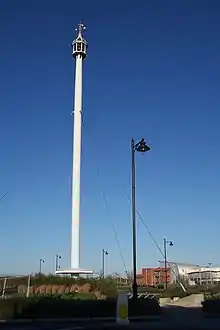HMS Undaunted (1861)
HMS Undaunted was a wooden screw frigate, the fifth ship of the name to serve in the Royal Navy.
.jpg.webp) HMS Undaunted | |
| History | |
|---|---|
| Name | Undaunted |
| Builder | Chatham Dockyard |
| Laid down | 28 May 1859 |
| Launched | 1 January 1861 |
| Completed | 16 July 1861 (for Reserve) |
| Commissioned | 2 March 1875 |
| Fate | Sold for breaking up in November 1882 |
| General characteristics | |
| Class and type | Bristol-class frigate |
| Displacement | 4,094 long tons (4,160 t) |
| Length |
|
| Beam | 52 ft 1 in (15.9 m) |
| Draught | 22 ft 9 in (6.9 m) (loaded) |
| Installed power | 2,503 ihp (1,866 kW) |
| Propulsion | 1 shaft, 1 Steam engine |
| Speed | 12 knots (22 km/h; 14 mph) |
| Complement | 550-600 |
| Armament |
|
She was the last of the Bristol-class, (which included Bristol, Glasgow' and Newcastle, as well as Undaunted; other ships ordered to the same design were cancelled).[1] She was built as a composite wooden-hulled vessel, built with a telescopic funnel and hoisting screws. She was ship rigged throughout,[2] It is thought that the installation of a wrought iron mast in HMS Undaunted may have been experimental.[3]
After launching, she went to Sheerness Dockyards for completion, and was then put straight into Reserve[2] She was commissioned under Captain Hugh Campbell, sailing for the East Indies as the Flagship of Rear Admiral Reginald Macdonald.
Undaunted had some distinguished Captains, including Captain Harry Woodfall Brent, (1834–1911), who commanded Undaunted later in 1875.[5]
She was then commanded by Captain Nathaniel Bowden-Smith, East Indies, again as the flagship of Rear-Admiral Macdonald, then of Rear-Admiral John Corbett (until he transferred his flag to HMS Euryalus). In 1879, Undaunted, under Captain John D'Arcy, returned to Chatham,[6] where she was decommissioned and then scrapped in 1880.[7] She was finally sold in 1882.[2]

Bell mast
The iron bell mast from this vessel still survives at the Chatham Royal Dockyard site. It is 100 ft tall and weighs 20 tonnes, it was then refurbished and erected in 1903, and the bell was rung to signal each change of shift for the dockyard employees until its closure in 1984. In 1992, the mast was taken down for repair and storage,[7] due to the construction of the Medway Tunnel.[8]
In April 1999, The bell mast was listed as Scheduled Ancient Monument.[9] It was restored and re-erected in 2001,[7] it now stands at the new entrance to the Historic Dockyard (visitor attraction) off Leviathan Way.[3][8]
Notes
- Lyon & Winfield: The Sail and Steam Navy List: All the Ships of the Royal Navy 1815–1889.
- MacDougall, Paul (1984). Chatham Built Warships Since 1860. Cornwall: Maritime Books. p. 4. ISBN 0907771076.
- "Chatham Bell Mast". britishlistedbuildings.co.uk. Retrieved 3 March 2013.
- "Harry Woodfall Brent R.N." pdavis.nl. Retrieved 5 March 2013.
- "Captain John D'Arcy R.N." pdavis.nl. Retrieved 5 March 2013.
- "THE BELL MAST". pastscape.org. Retrieved 28 August 2016.
- Muir, John (31 August 2013). "The Bell Mast at Chatham – historic monument and waymark". 4d-studio. Retrieved 28 August 2016.
- "APPENDIX 1, SCHEDULED ANCIENT MONUMENTS AT APRIL 1999" (PDF). medway.gov.uk. April 1999. Retrieved 28 August 2016.
References
- "Various British Screw Frigates". Warship International. Toledo, OH: Naval Records Club. V (4): 323. 1968.
- Gardiner, Robert, ed. (1979). Conway's All the World's Fighting Ships 1860–1905. Greenwich: Conway Maritime Press. ISBN 0-8317-0302-4.
- Lyon, David & Winfield, Rif: The Sail and Steam Navy List: All the Ships of the Royal Navy 1815–1889 Chatham Publishing, 2004. ISBN 1-86176-032-9.